
I arrived at Sofia airport Saturday morning. At the arrivals hall, I located a person with my name on a sign, who led me to a driver who took me to my hotel. With my morning arrival, my room was not ready. It was raining in Sofia. I pulled my raincoat out of my luggage and started exploring. I had lunch at a small Turkish restaurant, I got cash at an ATM, and stumbled across a large outdoor (covered) market with fresh fruits and vegetables, and everything else imaginable for sale.
My travel package was quite a bargain. A full week of touring Bulgaria with hotels, transportation, and a full-time guide cost only $1,150. I was one of three people in the group. And in another small world story, one of the three travelers was from Milwaukee. The other traveler was from Australia.
By the time our city walking tour started at 4pm, the rain had cleared. Our guide, Valentina, was amazing—quite knowledgeable, and incredibly passionate about Bulgarian history. I was fascinated with hearing about the corrupt politicians, and that it takes bribes to get anything done. That has really held Bulgaria back economically compared to some of the other Eastern European countries in the EU. They just accept corrupt politicians as the way things work.
We had a tasty dinner in the main pedestrian-only street of Sofia. Our guide recommended tongue for dinner, but I was not that adventurous. Erroll from Australia had it. Although I am not certain, Florence Welch (Florence and the Machine) may have been at a nearby table. Our tour included hopping on a few trams to get from place to place. Sofia public transit is so easy to use—just tap your credit card at a box on the tram/bus or at the subway turnstile. But once your total fare has reached four leva for the day (about $2.40), your card is not charged more than that, no matter how often you use it.
Sofia has water taps everywhere from mineral water springs. I saw lots of people filling water bottles. The water was warm at a few of the taps. Valentina filled her water bottle, so that was some confirmation that the water was safe.
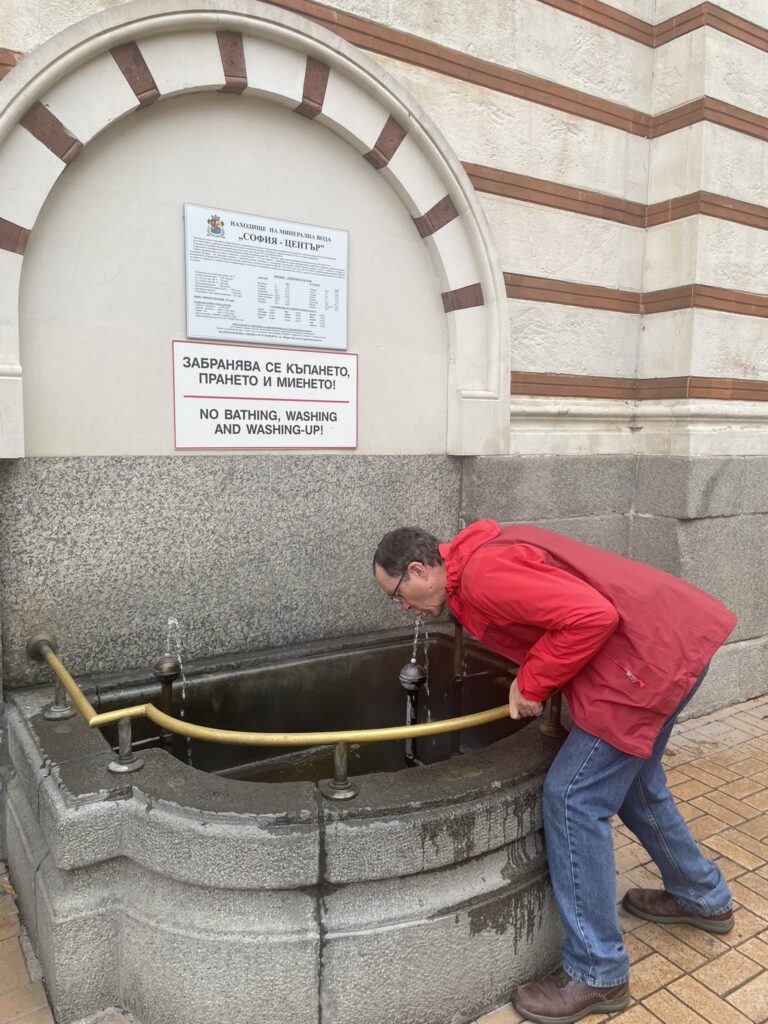
There were excavated ruins throughout the central part of the city, including ruins they found when building a subway. The central city was an interesting mix of classy older buildings, ruins, with some Communist-era ugly architecture here and there.

On Sunday morning, we met our guide for the rest of the trip, Bilyana, and headed south up in the mountains to Rila Monastery. Built in the 10th century, it is now a UNESCO world heritage site. We were there on a Sunday, which was a special holiday, and it was crowded. But it was interesting because we could go inside in the middle of a service. In the Bulgarian Orthodox church, there are no pews, everyone stands. We then continued further south, close to the Greek border, to the wine town of Melnik. After checking into our hotel, we walked a few blocks to a winery and enjoyed a wine tasting. One of the wines was especially good. We then learned some interesting history of that wine. At the Yalta conference at the end of WWII, Joseph Stalin served a wine from Melnik. Winston Churchill liked that wine so much, he had five hundred bottles sent to London. He continued to order five hundred bottles of that wine for years. The hotel we stayed at was older and had a lot of charm. This was also the first of several hotels in Bulgaria where the shower is right next to the toilet in a small bathroom, with a drain in the middle of the floor. After a shower, the floor stays wet, the toilet gets wet, etc. This arrangement clearly takes up a smaller footprint, but it otherwise makes no sense. Also, other than our hotel in Sofia, none of the hotels we would stay at had elevators. After the wine tasting, we walked to a local restaurant and had a nice and inexpensive dinner, with Melnik wine, of course.
The next day we drove the narrow, curvy roads through the mountains. We stopped at a small village and had a fantastic (and cheap) lunch with a view of the mountains. Then we made our way to the town of Bansko, where we stayed overnight. Bansko is a resort town in the mountains. We were told that the city is terribly busy in the summer and jam packed in December through March. But it was not yet skiing season, and the town was quiet. We had a lovely stroll through the uncrowded pedestrian zone, with a gorgeous view of the mountains with a ski lift at the end of the road. We had dinner at a traditional Bulgarian restaurant that was nice. At our hotel, breakfast was typically served from 8 to 10. Bilyana explained that if we wanted breakfast, our only choice the next morning was to have it at 7am. That was because the owners have a potato farm. The next morning was their day to harvest potatoes, and they needed to leave by 8am. At breakfast, the lady proprietor was enthusiastically telling us in Bulgarian about the potato harvest. The only English word she used in her conversations with us was “potato.” She showed us pictures of huge bags of potatoes. If Bilyana had not filled us in, we would have been completely clueless about her story.
The next morning, we first headed to a bear sanctuary, then to a small town for lunch. After lunch, the three tour participants boarded a historical train on a narrow-gauge railway line. While we had an enjoyable, scenic, and slow train through the mountains, Bilyana drove the car to where we would depart the train. We then headed to Plovdiv.
Before planning this trip, I had never heard of Plovdiv. Now, Plovdiv is in my top five list of favorite places in the world. Plovdiv is the oldest continuously inhabited city in Europe. It is built around seven hills. People have lived here for over 8,000 years. The ancient name of the city was Philipopolis, or Philipi. When the Apostle Paul wrote his letter to the Philippians, it was for the people here.
Our hotel was in the old town. Bilyana (who lives in Plovdiv) had permission to access a gate to enter the restricted area. I am glad I was not driving. The old town has steep, extremely narrow, cobblestone streets. It is okay for walking, but a challenge for driving or parking a car. We stayed two nights at a small, family-run hotel that was more than a hundred years old. We had dinner the first night at a craft brewery that was a short walk from our hotel. I had a large “dark lager,” that was one of the tastiest beers I have had in any city. It was so good, I had a second one. The food was rather good as well.
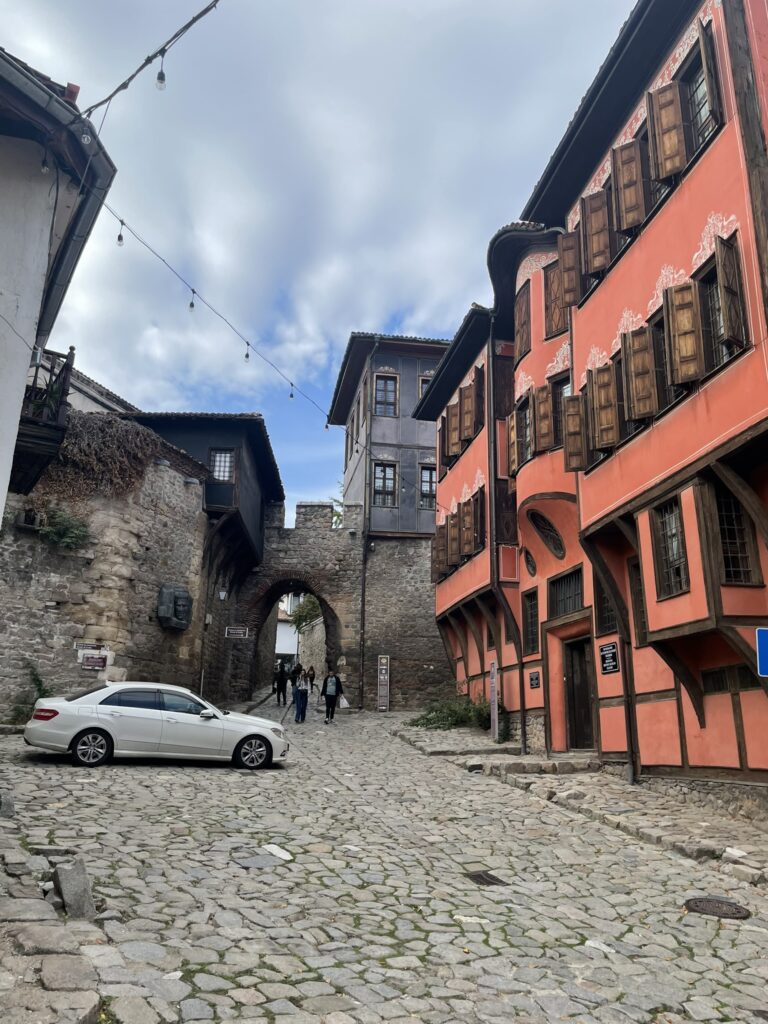
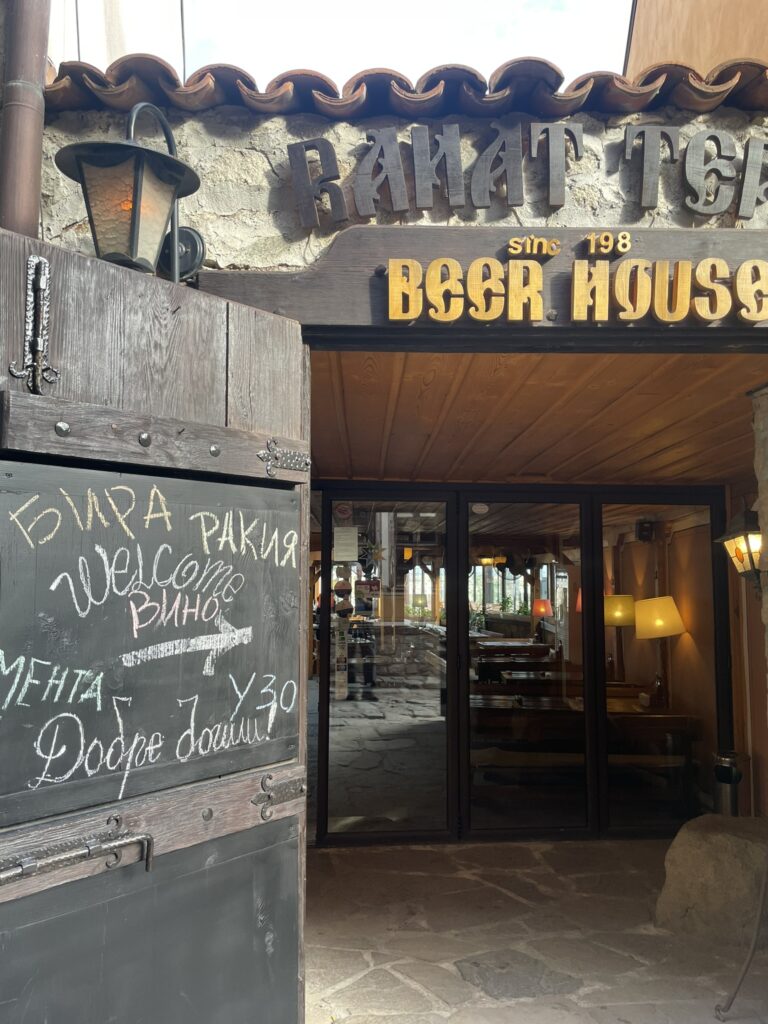
The next day, we had a city tour. Our first stop was one of the most fascinating museums I had ever seen. In the 1980’s, they discovered an early Christian temple from the fifth century in the central part of town. They began unearthing the ruins. With some international funding, they ended up building a museum around the ruins. The mosaic floors were very well preserved, and housed in a well-done, modern, indoor setting.

A few blocks away, we saw the Roman forum, including a small theater where events are still held. Nearby the forum, and clearly out of place, was the huge, unappealing, square block of a building that was the Communist area post office. We then started a long stroll through a wide pedestrian-only zone lined with shops and restaurants. Towards the end of the walk, we toured an underground area that was the start of a Roman stadium from around the year 200. Our entire walk in the pedestrian zone had been on top of this ancient stadium. They discovered the stadium well after all the streets and buildings were in place. We stepped inside an H&M that had glass covering part of the floor where you can see the ancient ruins below street level.

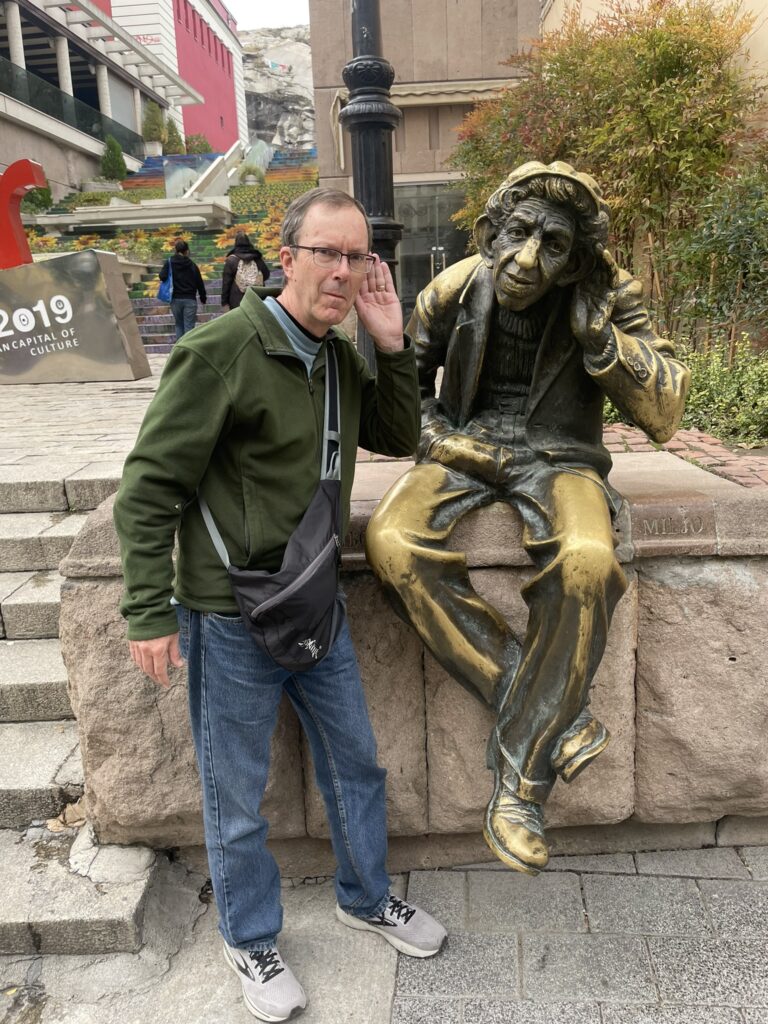
In the afternoon, we saw the highlight of the city: An incredibly well-preserved Roman amphitheater. They still hold events here. A tunnel with a six-lane road goes underneath the amphitheater. The weather that afternoon was perfect. We were the only people there for a while (there was an entrance fee of three leva for seniors-less than $2). I was sitting on the same marble seat that someone was sitting on watching a performance 2,000 years ago—that was hard to comprehend.

We had dinner in a pedestrian-only area of the old town. There were many restaurants in this area with outdoor seating, and they were all packed. The meal was great. The waiters were friendly with excellent English skills. This place has a nice laid-back vibe to it.
On our way to our next stay, we had a stop at a small city with an incredible church at the top of a hill. We then drove to one of the highest spots in the mountains and stopped at a large, abandoned building that looked like a spaceship. It was a Communist-era edifice. You could not go inside, but what an unusual sight at the top of a mountain. We also stopped at an open-air museum that was recreating life in the 1800s. It reminded me of Old World Wisconsin. I purchased a dried, plum-based candy made on-site the same way they made it 150 years ago. I also had my first drink of Boza, a wheat-based drink popular in Bulgaria. I liked it, but my fellow tour participants did not. We continued to the town of Veliko Tarnovo, the ancient capital of Bulgaria. Bilyana missed the turn in the old town to our hotel, and google maps took us on a crazy route to get back there through incredibly narrow cobblestone streets. We were here for two nights.

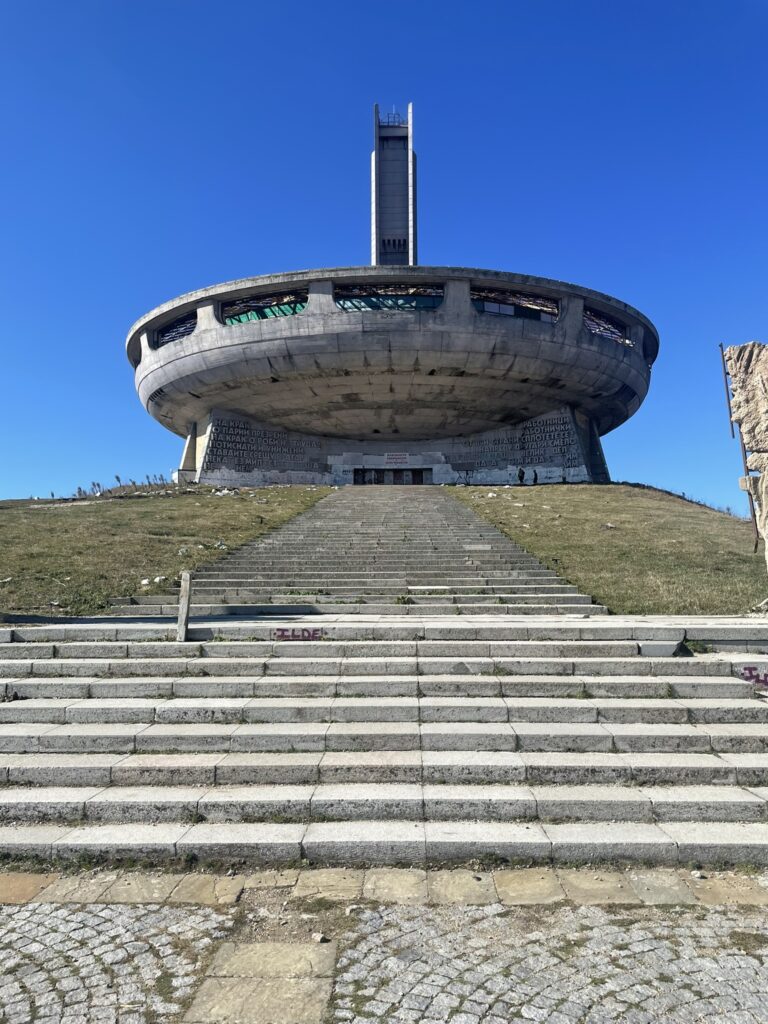
The main highlight of the town is a fortress on top of a very tall hill next to a river, which was the capital of the Bulgarian kingdom for several centuries. Once you are there, you understand how this was the ideal location to have a small city that was impossible to attack. The Bulgarian Empire at the time fell only because a traitor had let the Ottomans in through a back door.
The buildings, including a church, were remarkably well-preserved. This was a special place, and very few people were there! I was wearing my Packers shirt while at the Fortress that day. I heard a loud “Go Pack” chant from just outside the church. A man and his wife from Indiana were visiting Bulgaria, and he grew up in Wisconsin. We had dinner that night at a restaurant Bilyana recommended, that was just a delightful place with excellent food.
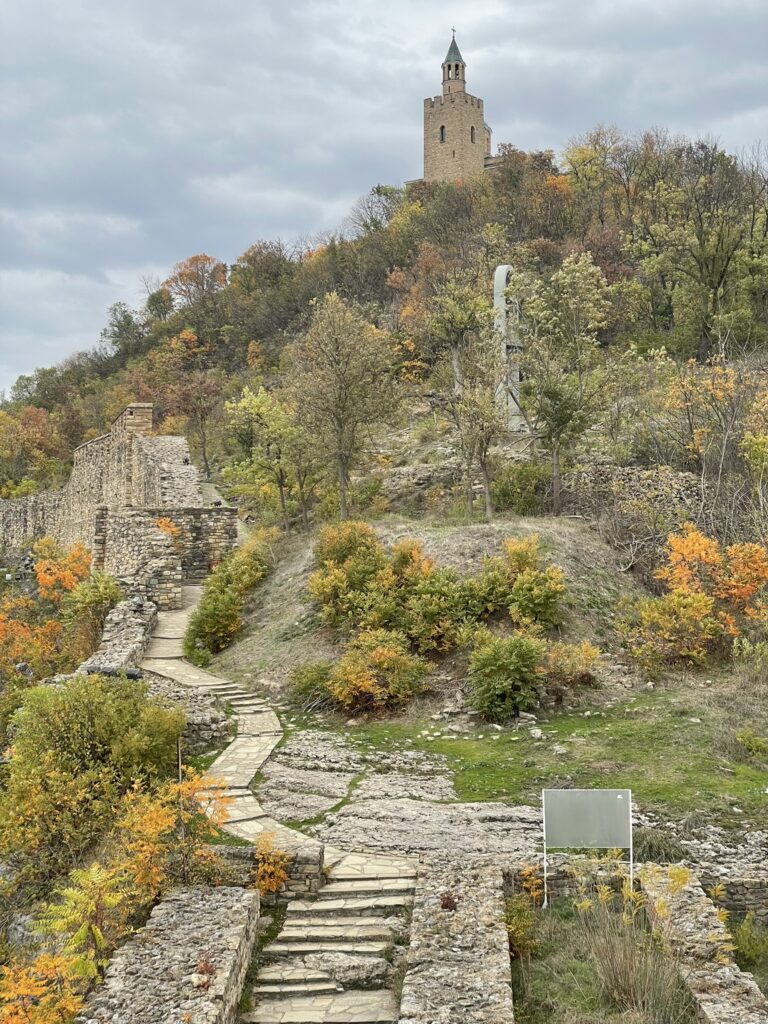
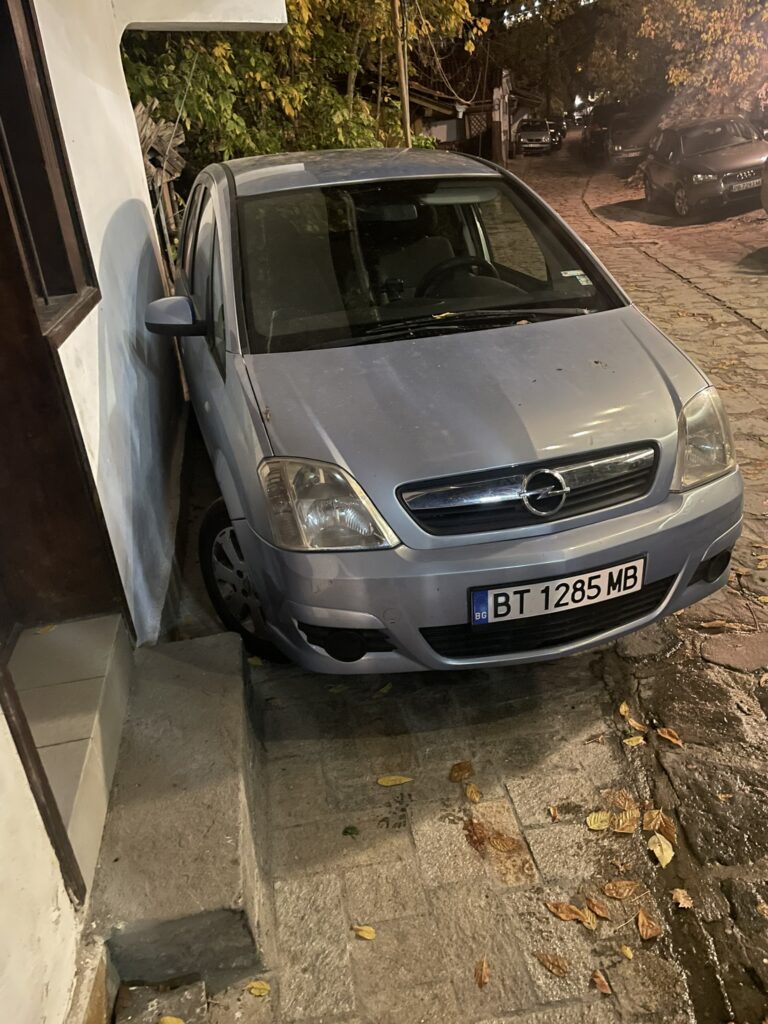
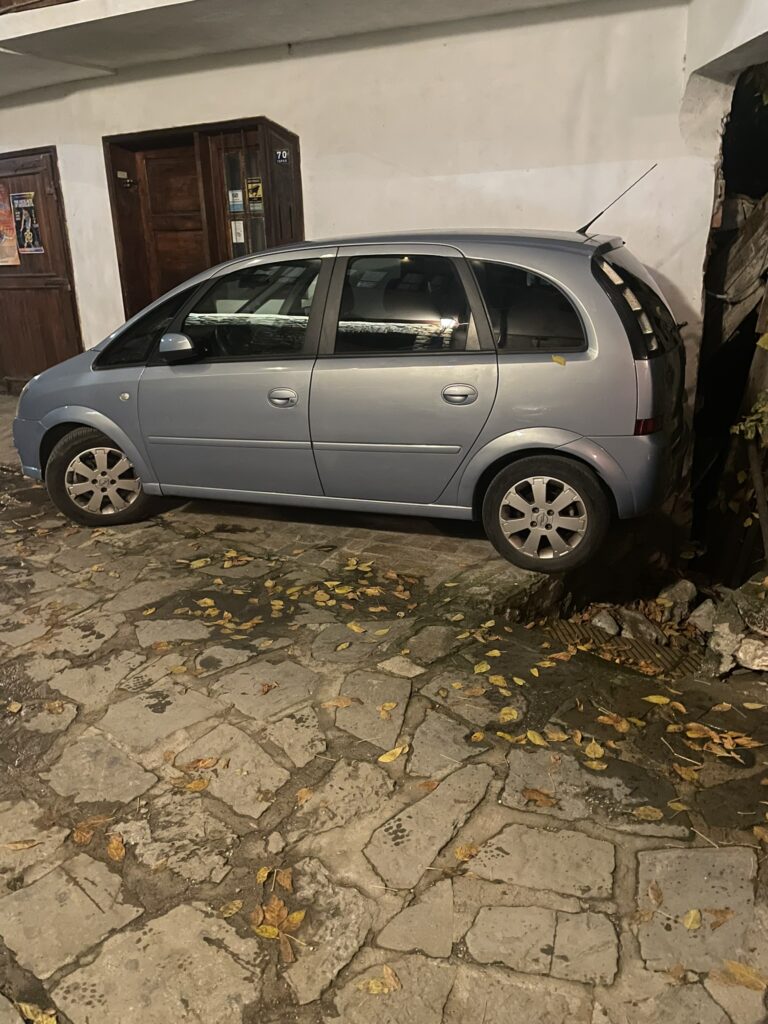
The next day was our three-hour car journey returning to Sofia. We stopped at an interesting rock/cave formation with an active bat population. We then stopped at a nearby town, Lovech, which had a bridge that is like Ponte Vecchio in Florence. Then—oops—as Bilyana was backing out of our parking space, we heard a crunch. She had backed into a car that was not parked in a legit spot. There was only minor damage. After leaving a note on the windshield of the other car, off we went. We had lunch at a charming little restaurant just off the two-lane highway about an hour away from Sofia. This was a small place-one server and one cook. I had lamb and vegetable soup, hot pork cabbage rolls, and homemade bread, all for ten leva ($6). Bilyana dropped me off at my hotel in central Sofia, and that was the end of the one-week guided tour.

My hotel my last two nights was a sweet deal. A benefit of my credit card is that once per year, I can get a $200 credit on a stay at certain hotels, as well as breakfast, a $100 credit to spend at the hotel restaurant, and a room upgrade if available. InterContinental Sofia is one of the hotels in this program. I paid $368 for two nights ($84 per night after the credit). I had a nice dinner at the restaurant (alcohol is not included in the benefit so the meal cost me $7 for a large draft beer). My room was by far the largest hotel room I had on the trip. I was upgraded to a terrific view. I was one block from the subway stop that went directly to the airport, which made for quite easy travel to the airport on departure day.
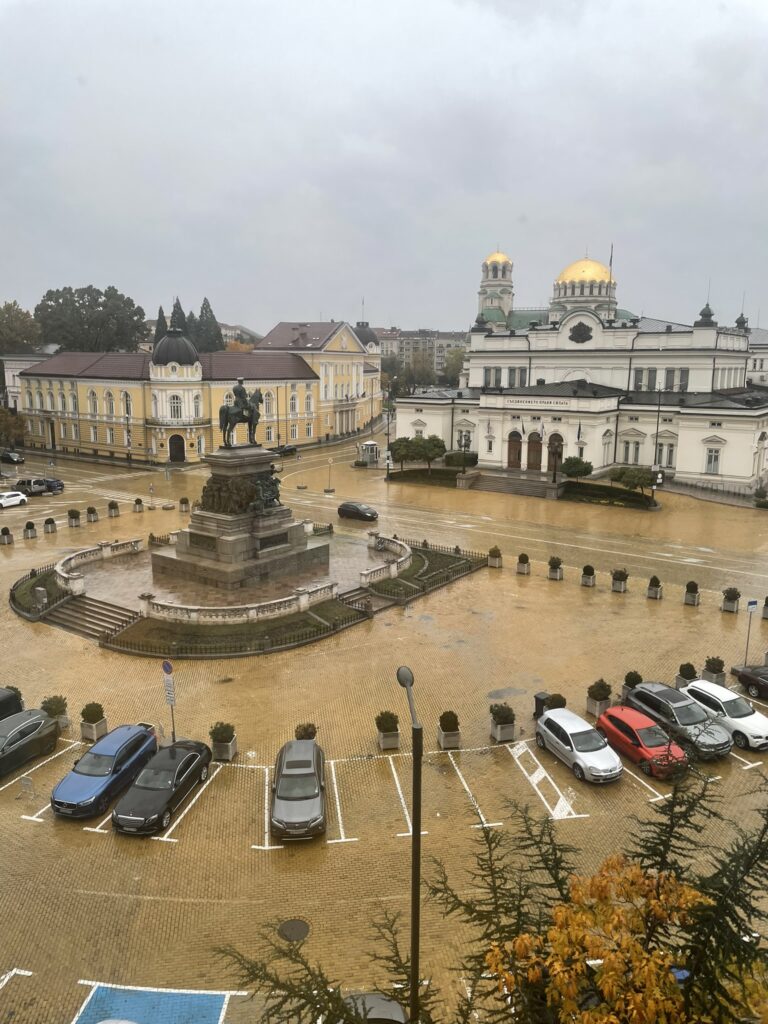
For the two days on my own in Sofia, I did a few organized tour things: A Pub Crawl to five unique and hidden bars (there were seventy-five people in the group—not exactly what I had envisioned!), and a small bites food tour. They were both worthwhile, and I met some interesting people. Selim from Istanbul encouraged me to connect with him when Cindy and I are in Istanbul next spring.
On Sunday morning, I went to the English language Mass at the one Roman Catholic church in Sofia. The church was one stop on the subway line. Whenever I exit a subway station in an unfamiliar place, I never know what exit to take. I usually just take the exit I see most people going to, surface, then look around and check Google Maps to see where I am. That was not necessary this time. I was in the last subway car. I saw an exit right where I got off the train. I took that exit. When I got to the top of the stairs and went to the turnstile, I could turn right or left to go up another set of stairs. Flip of a coin. I went right. At the top of the stairs was the front door of the church. Cool-that is not how it normally turns out for me! While the Mass was in English, all the prayers that were sung were in Latin. It rained on Sunday afternoon. I went to the archaeological museum (it was free that day!), went on my “small bites” food tour, and then enjoyed a craft beer to try and spend down the small amount of leva currency I had remaining. The rain (and wind) picked up, so by 6pm I was back at my hotel, where I had dinner and an easy evening.
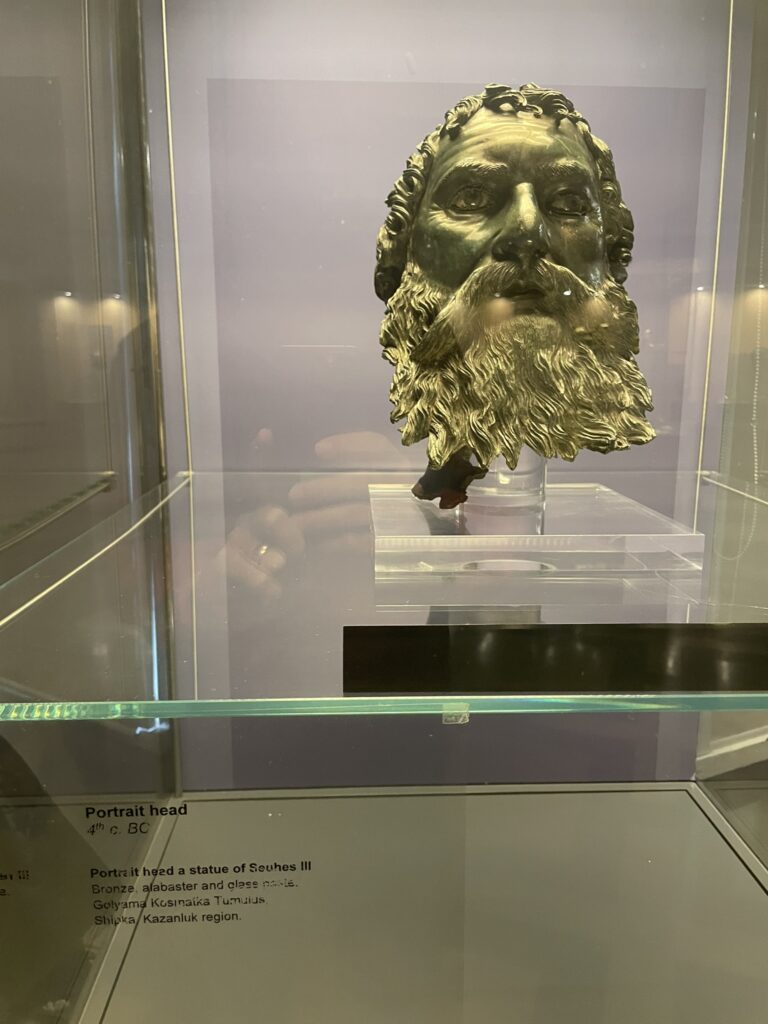
My flight from Sofia to Madrid on a Monday morning was on Bulgaria Air. My seat was in the last row. I was in boarding group 9. The flight was full. I decided to check my bag instead of facing the stress of struggling to find overhead bin space. The surprise of the flight was that they served everyone a hot sandwich, and it was tasty! When I arrived in Madrid and was waiting at the baggage belt, I checked on my bag using my Apple Air Tag. Uh oh-last location was Sofia. I was prepared for the worst. But the second bag off the belt was my bag! My Apple Air tag was still showing the last location in Sofia. When I looked closely, I saw that the last location was the previous day in an area of Sofia I had not been to! Mystery!!!!!!!

For my 20 hours in Madrid, I decided to stay in a nearby town with some history, Alcala de Henares. A bus departs from the Madrid airport every 20 minutes, and the fare is only €3. Hotels in Alcala are half the price of Madrid hotels. The city was charming. It is the birthplace of the author Cervantes, who wrote Don Quixote. Unfortunately, a huge and beautiful plaza area that is full of outdoor cafes was completely under construction and fenced off. Despite that, there were pedestrian only streets leading to the plaza with lots of shops and restaurants, with the street crowded with people. Unlike in Bulgaria, there was no English spoken in Alcala.
Iberia had been sending me e mail messages to arrive at the airport 4 hours early due to long lines at passport control, as Europe has started to implement a first-time registration system for non-EU nationals. I took the 6:33am bus. I arrived at the Iberia check-in counter exactly 4 hours before my 11:30am flight. Zero people were in line. Security took three minutes. I never broke stride at passport control and walked right up to an officer. They were not registering people for the new system. 15 seconds later, the officer stamped my passport. At 3 hours and 40 minutes before my flight, I was at the lounge with a lot of time to kill. I at least had a nice leisurely breakfast and got caught up on my e mail.
The flight from Madrid to Chicago was uneventful, as was the bus ride from O’Hare to Goerkes Corner where Cindy was waiting for me.
What an experience! I would like to make it back to Bulgaria sometime. But for now, it is time to start planning the next trip.
Leave a Reply